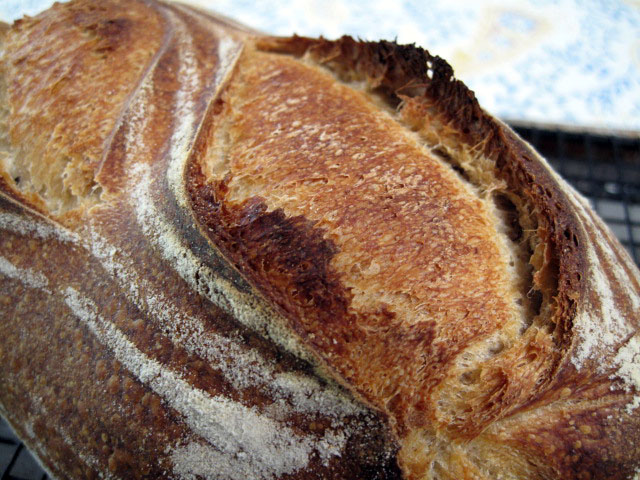This topic is not about the auricular anatomy of elves (or Vulcans). It's about scoring breads.
Scoring loaves creates a visually pleasing pattern, and it helps control the expansion of the loaf as it bakes. This was discussed not long ago in this topic:
http://www.thefreshloaf.com/node/9046/effect-scoring-loaf-shape
The San Francisco Sourdough breads I baked today illustrate a more "advanced" aspect of scoring that is alluded to by both Hamelman (in "Bread") and Suas (in "Advanced Bread & Pastry.")

San Francisco Sourdough Breads (from Peter Reinhart's "Crust & Crumb")

Detail of bâtard crust, with "ear," grigne" & "bloom."
So, what is the point of an ear?
What Suas called "the classic cut" is parallel to the long axis of a baguette or a bâtard. The cut is made with the blade at a shallow angle to the surface of the loaf. The cut should be shallow - about 1/4 inch deep. Paradoxically, this shallow cut results in the flap lifting better than a deeper cut would, thus forming a nice "ear." Hamelman (pg. 80) points out that "a deep cut will simply collapse from its own weight."
The angle is also important. "If the angle is not achieved and the cut is done with the blade vertical to the loaf, the two sides of the dough will spread very quickly during oven spring and expose an enormous surface area to the heat. The crust will begin to form too soon - sometimes before the end of oven spring - penalizing the development of the bread. If the cut is properly horizontal, the sides of the loaf will spread slower. The layer of dough created by the incision will partially and temporarily protect the surface from the heat and encourage a better oven spring and development." (Suas, pg. 116.)
The second photo, above, illustrates a fairly nice "ear," but it also shows that the bloom occured slowly, as it should. Notice that the color of the crust in the opening has 3 distinct degrees of browning, decreasing from left to right. The darker part on the left obviously opened first and was exposed to the direct heat of the oven for longer. If the bloom occured too rapidly, it would have a more even coloration. For example, see the photo of the boule, which was slashed with the blade held at 90 degrees to the surface of the loaf:

Boule scored with the blade held vertical to the loaf surface. Note the even coloration of the bloomed crust.
In summary, in order to achieve an optimal bloom in baguettes and bâtards, one must attend to 3 variables when scoring them:
- The cuts should be almost parallel to the long axis of the loaf.
- The blade should be held at about a 30 degree angle to the surface of the loaf.
- The depth of the cut should be shallow - about 1/4 inch.
Variable shading of the bloomed crust confirms that the desired slow but prolonged opening of the cut during oven spring occured.
Cool, isn't it?
David